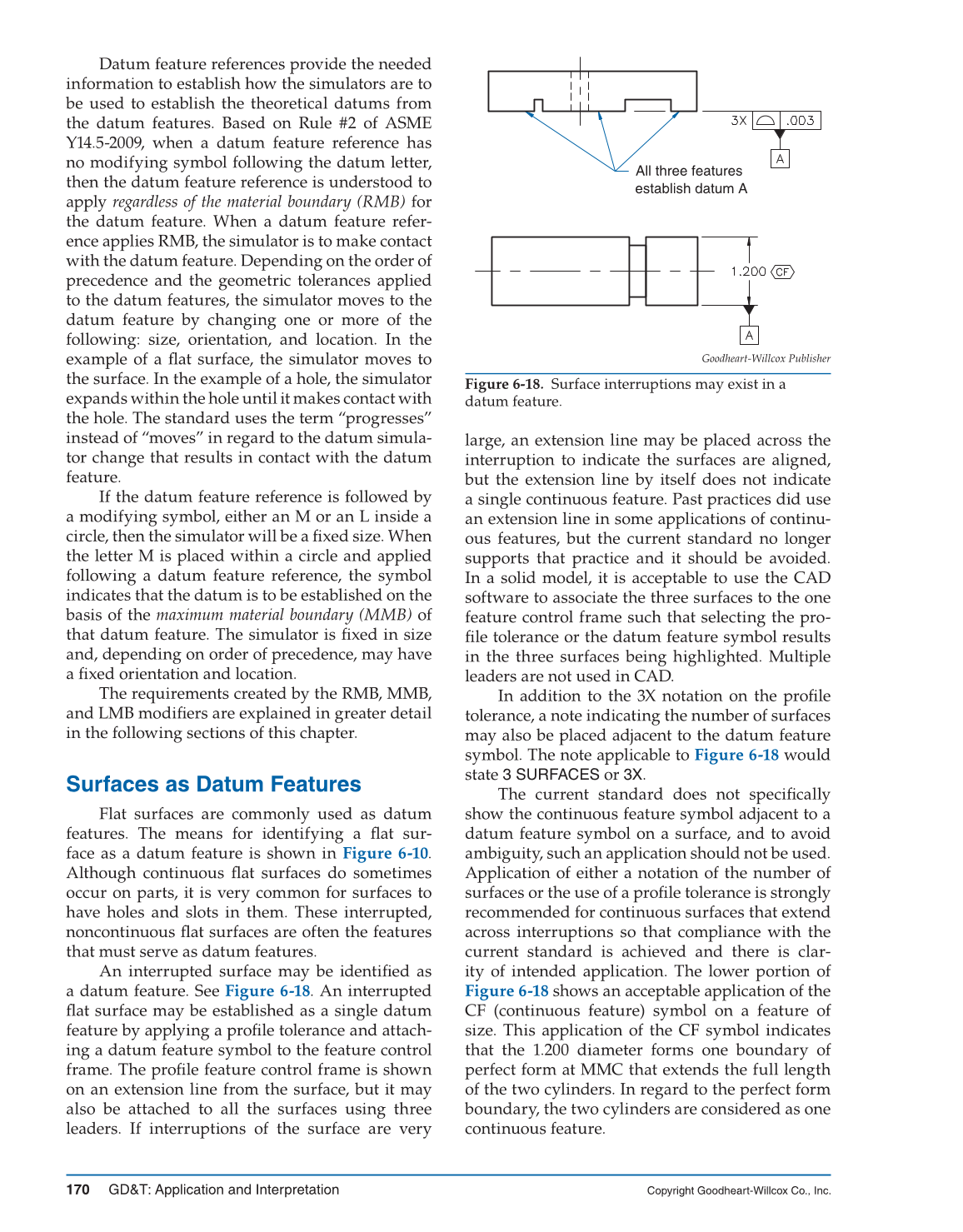170 GD&T: Application and Interpretation
Copyright Goodheart-Willcox Co., Inc.
Datum feature references provide the needed
information to establish how the simulators are to
be used to establish the theoretical datums from
the datum features. Based on Rule #2 of ASME
Y14.5-2009, when a datum feature reference has
no modifying symbol following the datum letter,
then the datum feature reference is understood to
apply regardless of the material boundary (RMB) for
the datum feature. When a datum feature refer-
ence applies RMB, the simulator is to make contact
with the datum feature. Depending on the order of
precedence and the geometric tolerances applied
to the datum features, the simulator moves to the
datum feature by changing one or more of the
following: size, orientation, and location. In the
example of a fl at surface, the simulator moves to
the surface. In the example of a hole, the simulator
expands within the hole until it makes contact with
the hole. The standard uses the term “progresses”
instead of “moves” in regard to the datum simula-
tor change that results in contact with the datum
feature.
If the datum feature reference is followed by
a modifying symbol, either an M or an L inside a
circle, then the simulator will be a fi xed size. When
the letter M is placed within a circle and applied
following a datum feature reference, the symbol
indicates that the datum is to be established on the
basis of the maximum material boundary (MMB) of
that datum feature. The simulator is fi xed in size
and, depending on order of precedence, may have
a fi xed orientation and location.
The requirements created by the RMB, MMB,
and LMB modifi ers are explained in greater detail
in the following sections of this chapter.
Surfaces as Datum Features
Flat surfaces are commonly used as datum
features. The means for identifying a fl at sur-
face as a datum feature is shown in Figure 6-10.
Although continuous fl at surfaces do sometimes
occur on parts, it is very common for surfaces to
have holes and slots in them. These interrupted,
noncontinuous fl at surfaces are often the features
that must serve as datum features.
An interrupted surface may be identifi ed as
a datum feature. See Figure 6-18. An interrupted
fl at surface may be established as a single datum
feature by applying a profi le tolerance and attach-
ing a datum feature symbol to the feature control
frame. The profi le feature control frame is shown
on an extension line from the surface, but it may
also be attached to all the surfaces using three
leaders. If interruptions of the surface are very
large, an extension line may be placed across the
interruption to indicate the surfaces are aligned,
but the extension line by itself does not indicate
a single continuous feature. Past practices did use
an extension line in some applications of continu-
ous features, but the current standard no longer
supports that practice and it should be avoided.
In a solid model, it is acceptable to use the CAD
software to associate the three surfaces to the one
feature control frame such that selecting the pro-
fi le tolerance or the datum feature symbol results
in the three surfaces being highlighted. Multiple
leaders are not used in CAD.
In addition to the 3X notation on the profi le
tolerance, a note indicating the number of surfaces
may also be placed adjacent to the datum feature
symbol. The note applicable to Figure 6-18 would
state 3 SURFACES or 3X.
The current standard does not specifi cally
show the continuous feature symbol adjacent to a
datum feature symbol on a surface, and to avoid
ambiguity, such an application should not be used.
Application of either a notation of the number of
surfaces or the use of a profi le tolerance is strongly
recommended for continuous surfaces that extend
across interruptions so that compliance with the
current standard is achieved and there is clar-
ity of intended application. The lower portion of
Figure 6-18 shows an acceptable application of the
CF (continuous feature) symbol on a feature of
size. This application of the CF symbol indicates
that the 1.200 diameter forms one boundary of
perfect form at MMC that extends the full length
of the two cylinders. In regard to the perfect form
boundary, the two cylinders are considered as one
continuous feature.
establish datum A
All three features
Goodheart-Willcox Publisher
Figure 6-18. Surface interruptions may exist in a
datum feature.
